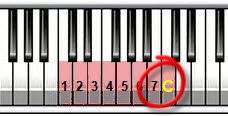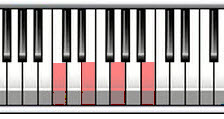Let’s Create Some Richness With Major 7 Chords
 Major 7 chords can really turn a simple major triad into something that sounds super rich. It has substance. We are going to take a shortcut approach to learning how to play Major 7 chords.
Major 7 chords can really turn a simple major triad into something that sounds super rich. It has substance. We are going to take a shortcut approach to learning how to play Major 7 chords.
Why do we call them “Major seven” chords? That’s pretty easy to illustrate. Let’s take a quick look at a Major scale, like the C Major scale:

Notice that the 7th note (or 7th degree) of the C Major scale is B. So, when we create Major 7 chords, we will be adding the 7th degree of that scale to the Major triad.
The 7th degree of the scale, as you can see above is just one half step lower than the C:

Well, since the piano keyboard is symmetrical and repeating, we also have a B one octave lower:

For The Sake Of Simplicity
While playing the Major triad, It’s actually a bit easier to picture this B for someone in the early stages of learning these chords, so we will take that approach:

Project “Major 7” Accomplished!
Once you add this 7th degree of the scale – which is exactly one half step lower than the name of the chord or scale – to a Major triad of the same name (C), you have a Major 7 chord!
The chord is a C Major 7 chord no matter where that B is positioned. However, since we are focusing on learning to play these chords in root position, we are going to actually play the higher B:

The above video is an excerpt from
The Ridiculously Easy Way To Master Those 7th Chords On The Piano

$19.99 Just $10 Today
(instant access sent to your email address)
The Major 7 Chord In Context
Here is an example of a C Major 7 chord used in the context of a tiny segment of The Way You Look Tonight by Jerome Kern & Dorothy Fields (notice the chord symbols):

Note that CM7 has an upper case “M” since we don’t want to confuse it with a minor type chord.
As mentioned in the short video above, make it a point to play these chords with both hands and have fun with them. Play them as arpeggios. Also, hold the chord down with one hand while the other plays the notes one at a time freely. Be creative!
Fingering A Major 7 Chord
When fingering these chords in root position, you will play with all fingers except your ring (or fourth) finger. This fingering works for all root position 7th chords:

You’re doing great! It will be of tremendous benefit for you to play these chords on all these roots:
C F Bb Eb Ab Db Gb B E A D G
Enjoy the process. You’re becoming a piano chord master!
Next, we will explore those dominant 7 chords…
